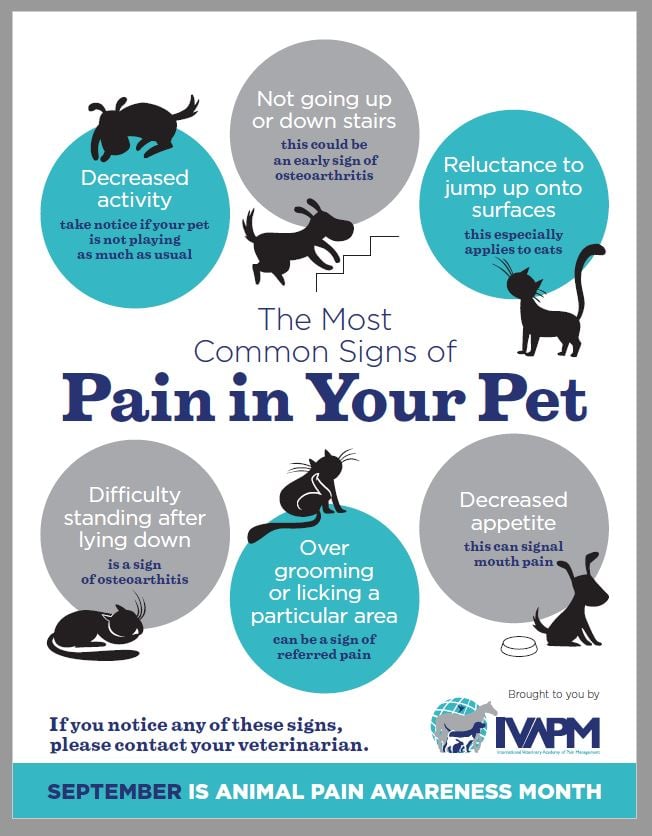How do you know if your dog is in pain? What signs or symptoms do you look for to tell your dog is in pain?
September is Pet Pain Awareness Month and the International Veterinary Academy of Pain Management (IVAPM) created this month to focus on sharing education and information with pet owners about their pet’s health and well-being. Oftentimes, people may not realize if and when their pets may be in pain. We reflect on this topic as part of September's Animal Pain Awareness Month. The International Veterinary Academy of Pain Management (IVAPM) created this to raise overall awareness and create a greater understanding of animals suffering from pain. As our company focuses on dogs, we will break out what you need to know about signs of pain in your dogs, sources of pain they may have as well as pain treatment options, some of which may surprise you. Read on for more information!
How do I know my Dog is in Pain?
An overall question for whether your pet might be in pain to ask yourself is:
"Are you noticing an usual behavior or change in their regular behaviors?"
If so, try to reflect upon what the change is and identify what might be the source of pain. According to the IVAPM, there are regular signs you can look for to determine if your pet is in pain.
signs your dog is in Pain:
- Decreased activity
- Not going up and downstairs
- Reluctance to jump on surfaces (or furniture)
- Difficulty standing after lying down
- Over-grooming or licking
- Decreased appetite
Trust your instincts. If you notice that your dog “always” does something and then is doing something quite different, there may be a problem. If you are reviewing these symptoms and you decide that indeed, your dog’s behavior has changed enough and you are concerned, contact your veterinarian.
Here’s a resource from IVAPM that makes the top 6 common signs of pain understandable visually:
Additional signs of pain:
There are also some underlying characteristics associated with pain that alter the behavior of a pet. This includes:
- Aggressive behavior
- Being anti-social
- Easily aggravated
- Heavy panting
- Shaking or trembling
Common causes of Pet Pain
There are two main causes of pain: acute and chronic. Acute pain is associated with something that just happened, such as a sprain injury or pulled muscle, or after recent surgery. Longer-term pain is considered chronic and can be of more concern. Chronic pain can be associated with types of cancers, dental disease, and arthritis in dogs.
How to help a dog in pain
If you think your dog might be in pain, here's what you can do:
- Keep a record of the change in behavior you are seeing.
- Make an appointment with your veterinarian.
- Explore all treatment options.
- Remember, you are your dog's advocate.
Our veterinarians are our main resource on how to identify the source of pain, and how to deal with it. Any information you can give to help pinpoint a diagnosis is invaluable. As you are learning about the cause of your dog's pain, ask about alternative therapies that might help. There are so many different treatments you may want to explore, depending on the source:
- Medicine. Remember to ask if there are any long-term effects, and how long you may need your dog on medications. What are the results you should be seeing on them?
- Surgery. Unfortunately for some injuries and tough diagnoses, surgery may be the best alternative.
- Rehabilitation. There may be exercises or something that can help remedy the situation your veterinarian can recommend.
- Alternative and holistic treatments. Laser therapy, acupuncture, hydrotherapy, and chiropractic care are just a few options now available for our dogs.
- Supplements. There is a variety to help with different ailments. Of course, as the maker of Glyde™ Mobility Chews, we pride ourselves on our joint supplement, one of the best, veterinarian-recommended joint supplements you can get!
mobility issues: Obvious Signs of Pain
Is your dog limping more or showing signs of stiffness? Are you noticing they are not wanting to jump up on the furniture? If you see something as if they are walking with a paw up, they may have an injury or something in their paw that is irritated. However, if they are moving less and not as active as they once were, they may be experiencing painful signs of arthritis.
Arthritis is a common health problem. It is also one of the most overlooked health problems. This is because often, we begin to offer excuses on why our pets have slowed down. We believe they are simply getting older when really our pets are starting to feel the signs of arthritis just as in adults. Remember: aging is not a disease, arthritis in dogs is. And you can do something to help your dog.
Arthritis in Dogs
Osteoarthritis (OA) or arthritis, is a joint disease affecting people, as well as dogs and cats. It is as painful for our fur-babies as it is for us. In healthy joints, a slippery tissue called cartilage cushions the ends of the bones in the joints. When arthritis is present, cartilage breaks down, causing pain and swelling. As it gets worse, bone spurs can form, causing more pain and joint damage.
Often, this is dismissed as simply "getting older." However, there are some very real issues with arthritis. And, just as there are things you can do for people, pets have options too.
There is also a short quiz you can take to assess your dog for signs of arthritis:
GLYDE MOBILITY CHEWS
Parnell Living Science, the makers of Glyde Mobility Chews, are experts arthritis in dogs. We created a unique formula with key ingredients to combat the signs of aging. Glyde uses natural, gluten-free ingredients to promote healthy joints to let your dog do everything he or she loves to do! Glyde is the only joint supplement that contains proven levels of three key components that work together to relieve the painful signs of arthritis.
Glyde's proven formula has all-natural ingredients and high levels of glucosamine and chondroitin, plus Green Lipped Mussel (GLM). The proven levels of these key ingredients are what makes the formula unique:
- New Zealand Green Lipped Mussel (GLM): A powerful anti-inflammatory
- Glucosamine: Reduces cartilage degradation
- Chondroitin Sulfate: Helps rebuild cartilage
There are many choices out there. Research and try what you need for your fur-baby! Just like people, every dog is different.
As we reflect on September's Pain Awareness Month, keep in mind your dog and how they have changed over the years. If you are starting to see them slowing down, consider Glyde™ Mobility Chews.
No matter what works for you and your dog, let's be sure to keep them happy and healthy. Remember they can't tell you if they are hurting. Assess their behavior regularly so you know if pain is an issue. As always, with regular check-up with your veterinarian, keep them posted on how they are doing as they age.
Because we all agree: dogs are part of the family! Let's keep them happy and healthy as long as we can!
Check out the IVAPM for more resources on what to look for in pain in other animals you may own such as horses, birds and cats. Special thanks to IVPAM for their resources. Visit their website for more information.






.png)

